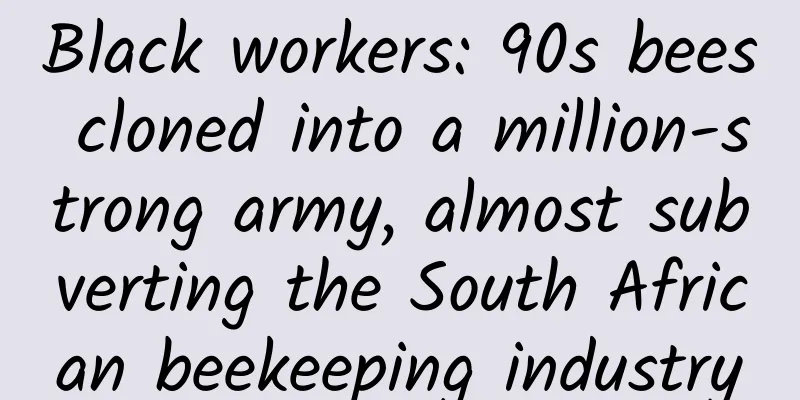Black workers: 90s bees cloned into a million-strong army, almost subverting the South African beekeeping industry

|
More, more, more. Written by | Krestrel Honey bees are well-known social insects, and are often used to describe hard workers. A typical bee colony consists of a queen bee (also called a queen bee), a small number of drones, and a large number of worker bees. There is a strict division of responsibilities among social bees. The queen bee and drones are directly involved in sexual reproduction and are responsible for the continuation of the family line, while the worker bees are responsible for raising young, building nests, foraging, and defense. (Here is the song of the working people) In order to maintain a balanced composition of the colony, the reproduction of bees is strictly regulated. Worker bees and queen bees hatch from fertilized eggs and are both female, while drone bees hatch from unfertilized eggs - that is, drone bees have no fathers. Generally speaking, offspring produced by sexual reproduction inherit a set of genetic material contributed by both the father and the mother. Whether it is worker bees, queen bees or humans, they all have two sets of chromosomes, which is called "diploid". The difference is that worker bees and queen bees have 16 pairs of chromosomes (32 in total), while humans have 23 pairs of chromosomes (46). Drones hatched from unfertilized eggs only have half of the normal chromosomes (16 in total), which is called "haploid" (because it has no father). Although worker bees and queen bees have exactly the same chromosomes, only the queen bee has reproductive function. Scientists have discovered that the reproductive function of worker bees is suppressed, mainly because of food. It turns out that the queen bee has always been fed with royal jelly, while the worker bees only eat royal jelly for three days after birth, and can only rely on pollen and nectar for food thereafter. Royal jelly contains substances that regulate gene expression, allowing the queen bee that has been eating royal jelly to develop a mature reproductive system. In addition, the queen bee also secretes pheromone, which further suppresses the reproductive ability of the worker bees. Therefore, worker bees are actually female bees with incompletely developed reproductive organs. However, in the absence of the queen bee for a long time, the ovaries of the worker bees can be activated. But they still do not have the ability to mate, and can only lay unfertilized eggs and develop into drones. This phenomenon of parthenogenesis is also called parthenogenesis. The offspring of worker bees are all male, so it is called arrhenotokous parthenogenesis (arrhenotoky). These drones can mate with the queen bees of other bee colonies and pass on the genome they carry. Before the swarm is split, the worker bees will build 4-10 "queen cells" in the hive. The larvae inside are fed with royal jelly and complete their development at about the same time. Generally speaking, only one queen bee is retained in a colony. The strongest queen bee that develops in these queen cells will become the new swarm leader, and the other queen bees will be killed by it. After the new queen bee is produced, it is time for reproductive swarming. The old queen bee will leave with some worker bees to establish a new colony. Correspondingly, since they will face a life-and-death struggle as soon as they emerge, the earlier they crawl out of the queen cell, the better it is for the queen candidate. The queen bee, which needs to mature as quickly as possible, develops the fastest (15-16 days), followed by worker bees (21 days), and drones the slowest (24 days). Unlike humans, bees have male and female sexes but no sex chromosomes. Their sex determination mechanism is quite special, called haplodiploidy, which mainly exists in Hymenoptera and some other arthropods. However, due to the great diversity of insects, this sex determination mechanism only accounts for 20% of all animals, so it is not so special. So, what determines the sex of a bee? From a molecular level, there is a locus called csd in the bee genome, which is the main gene locus that controls the sex of bees. Its full name is complementary sex determiner. In the bee population, there are about 19 different versions of the gene at this locus, that is, 19 alleles. Drones are haploid and naturally have only one csd gene. Queen bees and worker bees are diploid, so they have two csd genes, and the versions of these two csd genes are always different (called heterozygotes), because bees with the same version (called homozygotes) will die early in their development. Therefore, the csd locus is the most upstream signal that determines the sex of bees: csd heterozygous determines that it is female; csd homozygous, the bee cannot survive; only a single csd gene determines that it is male. There are also some special cases. For example, in highly inbred experimental populations, diploids with homozygous csd loci will develop into drones, but such drones are either infertile themselves or the triploid offspring produced by mating are infertile. This sex determination mechanism is compatible with the "eusociality" of bees. Eusociality means that a population must have three characteristics at the same time: reproductive division of labor, overlapping generations (mature individuals in a group can be divided into more than two generations, such as grandfathers and fathers living at the same time) and cooperative child rearing. The altruistic behavior of worker bees can be explained by the theory of kin selection. Relatedness (r for short) is a quantity used to measure the kinship between individuals. It is defined as the probability that two individuals share a gene and both copies come from the same ancestor (for example, the common gene between mother and child comes from the mother's father, that is, the child's grandfather; the common gene between sisters comes from their mother). Take worker bees as an example. The relatedness coefficient of the worker bee that lays eggs and the haploid drone it lays is r = 0.5, because the drone inherits half of its mother's genetic material and has a 1/2 probability of having a certain gene from its mother. The kinship coefficient between worker bees and drones produced by the queen bee is only r=0.25, because both are offspring of the queen bee: the probability that a drone has a gene from the queen bee is 1/2, and the probability that a worker bee, as the sister of the drone, also has this gene is also 1/2 (it may also come from another drone), so the probability that the gene shared by both comes from the queen bee is 1/4. However, there will not be only one worker bee laying eggs in a bee colony. The affinity coefficient of a worker bee to the drones laid by all worker bees is r≈0.125. In this case, compared with only caring for the drones laid by the queen bee, caring for the drones laid by other worker bees is actually a loss - why should we care for drones with a lower affinity coefficient? Of course, the higher the r, the more "one of us" it is. Therefore, in ordinary bee colonies, worker bees do not lay eggs themselves, and even remove the eggs laid by other worker bees. Doesn't it sound mean? Actually, the worker bees' behavior is to increase their generalized fitness. So-called fitness is the ability to produce surviving offspring, and the generalized fitness requirement is lower: you don't have to produce offspring yourself, it's OK if someone else's offspring contains the same genes as you. (My heart trembled: What a cute little creature!) However, more than a decade ago, beekeepers in South Africa discovered that their bee colonies were "overturned" by some worker bees that could lay eggs on their own. Even more dramatic is that the offspring produced by these strange worker bees have the same genome as their own, which is equivalent to cloning themselves! These bees are called cape honeybees, a subspecies of the Western honey bee (scientific name Apis mellifera). Its Latin name is Apis mellifera capensis, which is different from the subspecies Apis mellifera scutellata used in the general beekeeping industry. Figure 1 “Melanized, but not completely black.” The greater proportion of black on the abdomen is a convenient feature for distinguishing Cape honey bees. The genomes of the two subspecies are almost completely homologous. However, while the typical worker bee mentioned at the beginning of this article can only produce haploid drones, the Cape honey bee can lay diploid eggs on its own, which develop into worker bees or, if it occupies a queen cell, into a queen bee - you heard it right, a queen bee produced by a worker bee! This phenomenon is called thelytokous parthenogenesis (thelytoky). Seeing this, you may recall the scene in Resident Evil: Extinction: In front of Alice and her clones, more Alice clones were suspended in nutrient solution and placed in an endless grid of egg-shaped containers (Figure 2). You may also remember that in Resident Evil: The Final Chapter, the aging Alice left her memories to her clone - the protagonist Alice gave her a complete "personality" and hoped that she would survive in her place. In fact, entomologist Benjamin Oldroyd of the University of Sydney, Australia, also uses "reincarnation" (literally "re-dominance of the body") to refer to the process by which worker bees that cannot mate produce their own queen clones. Figure 2 Relevant scenes from the movie “Resident Evil: Extinction”. Indeed, over the past 30 years, the South African beekeeping industry has been terrified by the millions of Cape honey bee clones. When mixed in with populations of other subspecies, Cape honey bees are so-called "social parasites." These worker bees not only "illegally" lay eggs and compete for queen cells, but also emit pheromones that make ordinary worker bees raise them as young bees, almost enjoying the treatment of queen bees. They monopolize reproduction, causing the original population to gradually collapse, and then turn to invade new bee colonies. Cape bee colonies can survive for several months without a queen bee until a new queen bee is produced. In the 1990s, 50,000 bee colonies in South Africa were destroyed every year because of this, and Cape bees were banned from Europe, the United States, Australia and other places. The social parasitism of Cape bees was first discovered after bees were introduced from Brazil to South Africa. Fortunately, it was dealt with quickly at the time, otherwise it might not be called Cape bees. Figure 3. The Cape honey bee has a very narrow geographical distribution, confined to the southernmost part of the African continent (green area). As we all know, the body of a bee is black and yellow stripes, but in the abdomen of the Cape bee, the black color is more prominent (Figure 1), which makes it easy to identify it. The Cape bee, which can appoint its own leader (queen bee) and produce its own army, can be regarded as a black worker. How do Cape honey bees pass on a full set of chromosomes to their offspring? The eggs of Cape bees also undergo meiosis II, but after the chromosomes are separated, the nuclear membrane and cell membrane are not formed immediately. The four pairs of chromosomes, that is, the four pronuclei, are arranged in a row, and then the two pronuclei in the middle (containing two sets of chromosomes from non-sister chromatids) fuse ("central fusion") to restore diploidy. The workers of Cape bees always reproduce parthenogenetically, while the queens always reproduce sexually. Figure 4. Comparison of reproductive patterns between common honey bees and Cape honey bees. Parthenogenesis has disadvantages, the most prominent of which is the loss of genomic heterozygosity, which reduces the adaptability of the species. In the metaphase of the first meiotic division, chromosomes will undergo recombination and then undergo the "central fusion" process mentioned above. If the chromosome segment where a gene is located has been exchanged with the corresponding non-sister chromatid segment, in the egg that will eventually develop into a female, this segment will be the same copy on both sets of chromosomes. For any gene locus, heterozygosity should be lost by 1/3, because in the "central fusion" process, if any chromatid is selected, one of the remaining three will be exactly the same as it. Loss of heterozygosity is not conducive to survival. One important reason is that the adverse traits corresponding to some defective recessive genes will be manifested. For example, loss of heterozygosity is often found in cancer, and tumor suppressor genes are often found to be missing in the deleted areas. Researchers once believed that the Cape honey bee colony should decline quickly. But more than 30 years have passed, and this has not happened, perhaps because Cape honey bees have the characteristics of social parasitism. Researchers speculate that in addition to the homozygous lethal effect of the csd gene, there should be other unknown mechanisms to maintain the genomic heterozygosity of Cape honey bees. In short, Cape honey bees carry many mysteries that are waiting for us to solve. The last question is, when did rebellious “workers” like the Cape honey bees appear? The researchers found that all these Cape bees were descendants of the same mutant worker bee, which lived around 1990. You may ask, how did they find this out? Here we have to mention an important research method in ecology - satellite DNA. Satellite DNA is a type of highly repetitive gene sequence. It is a molecular marker that is often used to represent longer chromosome segments in ecology. It is called "satellite" because in cesium chloride density gradient centrifugation experiments of genomic DNA, it is always distributed outside the main band, like the position of a satellite. There is a type of satellite DNA called "microsatellite", which is composed of a large number of tandem repeats of sequences of 2-4 bases. By analyzing a large number of microsatellite sites in Cape bee samples, scientists found that except for a few mutations, all individuals at these microsatellite sites are either heterozygous for the only two versions of the microsatellite sequence, or homozygous for one of the two versions. This means that they all come from a mutant bee and are all on the parthenogenetic lineage of this "little ancestor" - it can be called Smith in the real world. This may sound a bit scary, but you can also understand it from another perspective. After all, the Cape bee mutation is a low-probability event, and the probability of such an event happening once is of course much greater than the probability of it happening twice independently (the latter probability is the square of the former probability). In fact, the Cape honey bee has a very narrow geographical distribution, limited to the southernmost corner of the African continent (Figure 3). For beekeepers in this area, the Cape honey bee is a lovely existence - easy to take care of, more adapted to the local ecological environment, more tolerant to Varroa destructor (the primary pest in the beekeeping industry), and can completely replace ordinary honey bees in terms of commercial value. For researchers, the Cape honey bee is the most interesting subspecies of honey bees. References [1] Baudry E, Kryger P, Allsopp M et al (2004) Whole-genome scan in the lytokous-laying workers of the cape honeybee (Apis mellifera capensis): central fusion, reduced recombination rates and centromere mapping using half-tetrad analysis. Genetics 167:243–252. [2] Beye, M., Hasselmann, M., Fondrk, MK, Page, RE, Omholt, SW, 2003. The gene csd is the primary signal for sexual development in the honeybee and encodes an SR-type protein. Cell 114, 419e429. [3] Jordan Lyndon A, Allsopp Michael H, Oldroyd Benjamin P, Wossler Theresa C and Beekman Madeleine 2008. Cheating honeybee workers produce royal offspring. Proc. R. Soc. B.275345–351 [4] Oldroyd Benjamin P., Yagound Boris, Allsopp Michael H., Holmes Michael J., Buchmann Gabrielle, Zayed Amro and Beekman Madeleine 2021. Adaptive, caste-specific changes to recombination rates in a thelytokous honeybee population. Proc. R. Soc. B.2882021072920210729. [5] Oldroyd, B., Allsopp, M., Lim, J., & Beekman, M. (2011). A THELYTOKOUS LINEAGE OF SOCIALLY PARASITIC HONEY BEES HAS RETAINED HETEROZYGOSITY DESPITE AT LEAST 10 YEARS OF INBREEDING. Evolution : International Journal of Organic Evolution., 65(3), 860-868. [6] Rabeling C. Social parasitism. In Encyclopedia of Social Insects (ed. Starr, C.) 836–858 (Springer, Berlin, 2020). [7] https://entnemdept.ufl.edu/creatures/misc/bees/cape_honey_bee.htm |
>>: Giving Up Syndrome and Beyond: The Weird Case of Mind-Body Problems
Recommend
National 400 telephone number, 400 telephone national unified service hotline
The 400 number has no area code and is a national...
What is the exposure mechanism of information flow advertising?
When doing information flow advertising, you may ...
Event operation and promotion: How to design a good lottery event?
This article analyzes and discusses how to design...
Why are humans right-handed?
"Why are humans right-handed?" is a que...
Xiangxue Classroom·“Golden March and Silver April” first-tier factory interview special topic, valued at 2180 yuan
Xiangxue Classroom·“Golden March and Silver April...
A universal formula for increasing followers on Xiaohongshu!
In the process of analyzing nearly 100 bloggers, ...
Shanghai SEO outsourcing company, how to find a suitable SEO outsourcing company?
Among the numerous SEO outsourcing companies, it ...
Android Studio 1.0 Apple computer installation and configuration
[[125025]] Preface Recently, Google finally lived...
What kind of soil can increase your worth? Answer: Moon soil!
After shopping, many people will jokingly say &qu...
What are the functions of the Guangzhou Auto Mini Program? How much does it cost to develop a WeChat car mini program?
In 2021, China's car ownership will reach 350...
Shen Gong...Gong...What animals are the true forms of the leopard family?
With the popularity of "Nezha: The Devil Boy...
3 information flow advertising cases in the financial industry, watch them all at once, so awesome!
Today, the editor has compiled 3 cases of informa...
Solid info! 6 customer acquisition models for APP promotion!
This time, I spent 2 days researching various pop...
From Li Jiaqi's IP: The "hidden rules" of cross-platform account operations
In the Internet age, information flows faster and...
Promotion account structure diagram, how to build a promotion account structure?
The account structure of search promotion consist...









